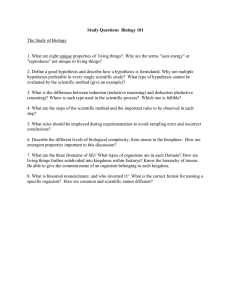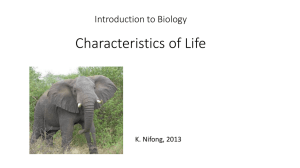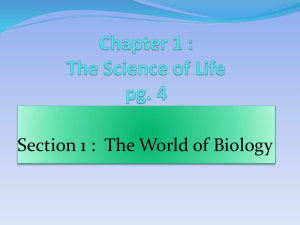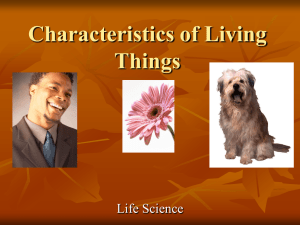Biology: The Study of Life - Chapter 1 Summary
advertisement
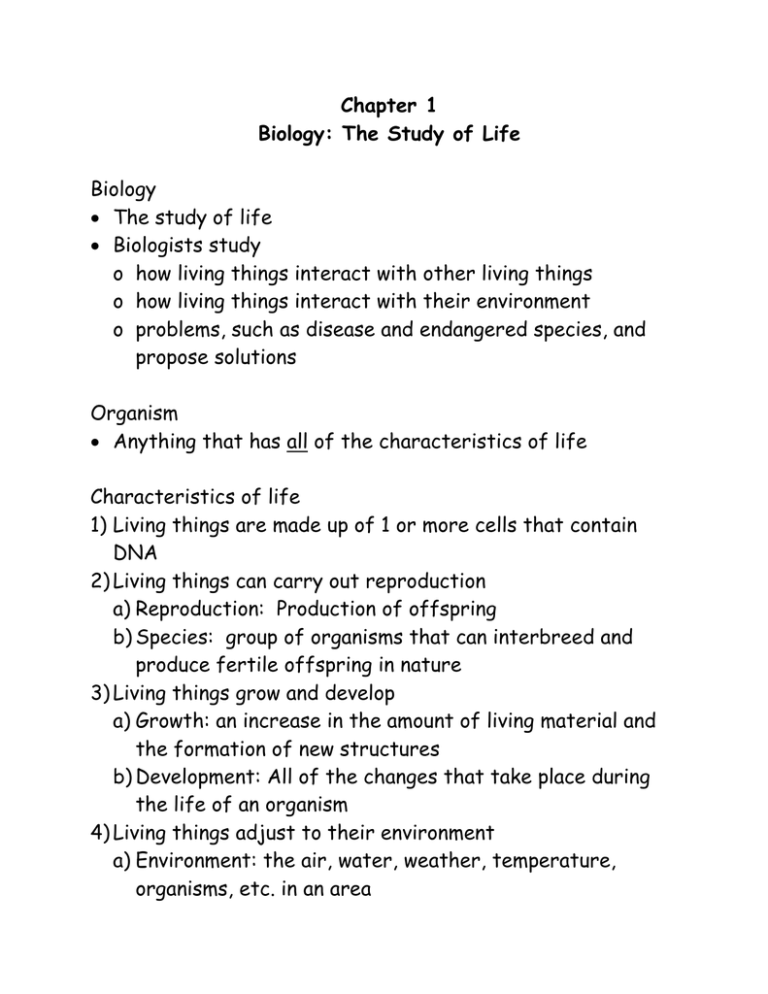
Chapter 1 Biology: The Study of Life Biology The study of life Biologists study o how living things interact with other living things o how living things interact with their environment o problems, such as disease and endangered species, and propose solutions Organism Anything that has all of the characteristics of life Characteristics of life 1) Living things are made up of 1 or more cells that contain DNA 2) Living things can carry out reproduction a) Reproduction: Production of offspring b) Species: group of organisms that can interbreed and produce fertile offspring in nature 3) Living things grow and develop a) Growth: an increase in the amount of living material and the formation of new structures b) Development: All of the changes that take place during the life of an organism 4) Living things adjust to their environment a) Environment: the air, water, weather, temperature, organisms, etc. in an area 2 b) Stimulus: anything in an organisms environment that causes the organism to react c) Response: the reaction of an organism to a stimulus d) Example: Stimulus-cold winter without food Response-bears hibernate e) Homeostasis: Controlling an organism’s internal system to maintain the conditions needed for survival f) Example of homeostasis: When your body starts to overheat, you sweat to cool yourself off 5) Living things need energy a) Energy: the ability to cause change b) Energy comes from food 6) Living things adapt and evolve a) Adaptation: A body structure, behavior, or internal process that allows an organism to respond to its environment and survive to produce offspring b) Evolution: The gradual change in a species through adaptations over time The Scientific Method The common steps that scientists use to gather information and answer questions 1) Observe a problem and ask a question 2) Make a hypothesis a) Hypothesis: an explanation to a question or problem (educated guess) that can be tested 3) Conduct an experiment to collect data a) Experiment: an investigation that tests a hypothesis b) Experiments can involve 3 i) A control group: the part of the experiment that receives no experimental treatment ii) An experimental group: The part of the experiment that receives experimental treatment c) In experiments, only one condition is changed at a time i) an independent variable: the condition that is tested ii) a dependent variable: the condition that changes due to the independent variable and is measured d) Data: information obtained from an investigation (measurements, observations, etc.) i) The data is analyzed in order to make conclusions 4) Publish data and conclusions in scientific journals for other scientists to read 5) Form a theory a) Theory: a hypothesis that is supported by a large body of evidence 6) Develop new hypotheses based on the theory 7) Revise the theory as new experiments are done Safety Safety is the number one concern when doing a lab Lab procedures in your book show safety symbols o Safety symbol: symbol that warns you about a danger that may exist from chemicals, electricity, heat, or procedures o Be familiar with the safety symbols on p.1107 4 Different kinds of data Quantitative data: numbers from measurements, counting, etc. o In biology, we use the metric system to make measurements meter: length gram: mass liter: volume second: time degree Celsius: temperature Qualitative data: written description from observations Ethics ethics: morals and values held by humans scientists might not consider all the possible applications for their discoveries society must use ethics and take responsibility for using science wisely Technology application of scientific research to society’s needs and problems technology improves our lives and the world around us but sometimes, technology can also hurt our lives or the world around us

